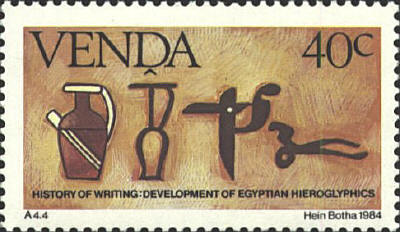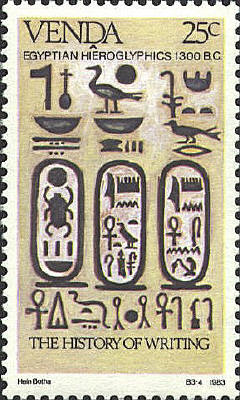|
The stamp shows the
development of a single Egyptian hieroglyph from a pictograph
(2700-2600 b.c.), through hieroglyphic book script (ca. 1500 b.c.) and
a form of hieratic script (ca. 1500 b.c.), b.c.), to demotic (400-100
b.c.). The table from which these forms were taken is in David
Diringer, The Alphabet: A Key to the History of Mankind, 3rd
edition. New York: Funk & Wagnalls, 1968, Vol. 2, p. 42, 2.6.c.

There are three
“cartouches,” the oval which contains a king’s name. The left
cartouche is Neb-kheperu-Re, the throne name of Tut-ankh-amun, which
is the content of the middle cartouche. The right cartouche is
Ankh-Hesen-Amun, Tut’s wife, and possibly his sister, or at least his
step-sister.


Hieratic Script
The hieratic script was based on hieroglyphic
writing from ca. 2900-200 b.c.
It was written on papyrus with a reed pen, vertically and later
horizontally from right to left.
The Ebers papyrus is a medical text written in
hieratic, dating from ca. 1500
b.c. It is about 20 meters long and about 30 cm high. It was
discovered in Luxor in the 1870s and is in library of Leipzig
University.
The Sotis Calendar is on the back of column 1 of the
Ebers Papyrus, also written in hieratic. Sotis is the Egyptian name
for the star Sirius, the brightest star in the northern hemisphere.
Titles and numbers are written in red, the remaining text is in black.


 |
